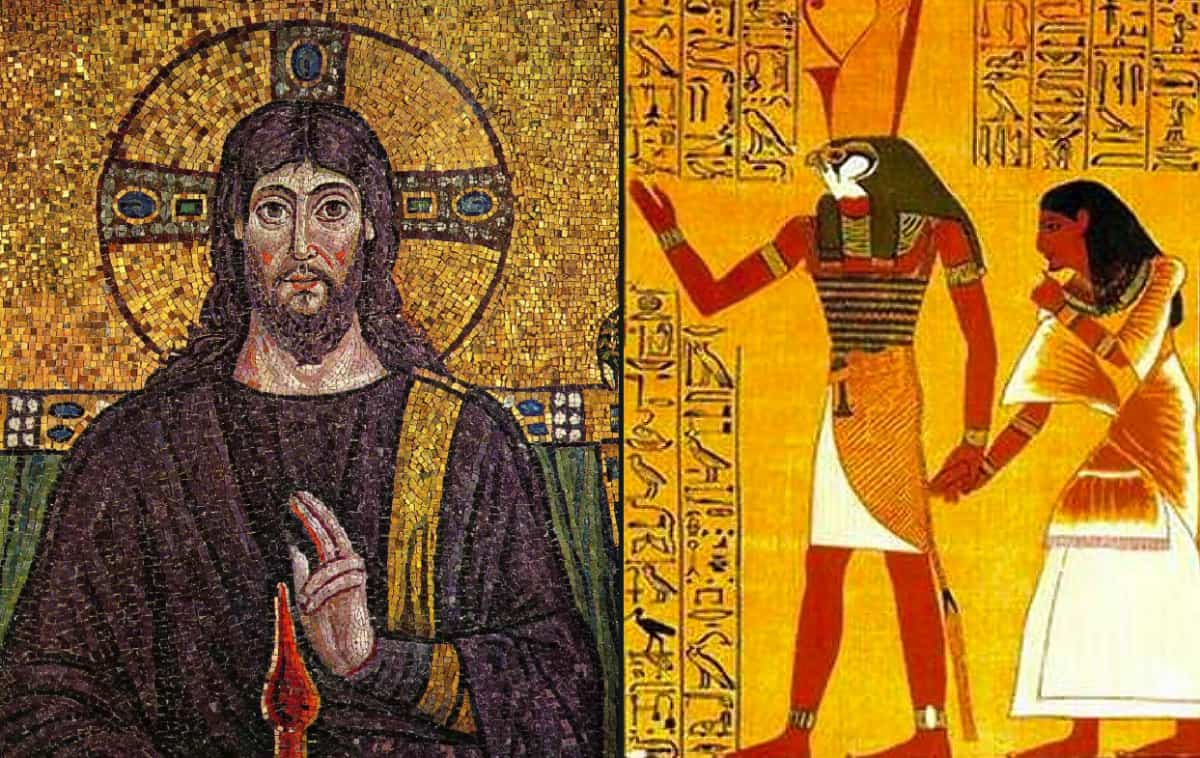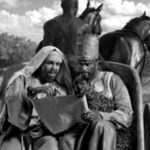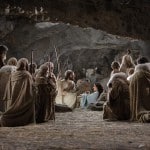HHA | 12/2/2014
Some Christmas fun from Lutheran Satire: “Horus Ruins Christmas.”

STR | Solid Ground | JULY 2007
There is a reason the ancient historical accounts of the life of Jesus of Nazareth do not start with the phrase, “Once upon a time….” On the face of it, the authors did not appear to be writing fairytales for future generations, but rather detailed accounts of the extraordinary events in the life of a particular Jewish carpenter who actually changed the course of history.
The opening words of Luke’s account of Jesus’ life are especially clear on this point:
Inasmuch as many have undertaken to compile an account of the things accomplished among us, just as they were handed down to us by those who from the beginning were eyewitnesses and servants of the word, it seemed fitting for me as well, having investigated everything carefully from the beginning, to write it out for you in consecutive order, most excellent Theophilus, so that you may know the exact truth about the things you have been taught.
In the days of Herod, king of Judea….
In John’s account we find two striking claims that bookend his record, the first found in Chapter 1 and the last in Chapter 20:
In the beginning was the Word, and the Word was with God, and the Word was God….And the Word became flesh, and dwelt among us, and we saw His glory, glory as of the only begotten from the Father, full of grace and truth. Many other [miraculous] signs Jesus also performed in the presence of the disciples, which are not written in this book, but these have been written so that you may believe that Jesus is the Christ, the Son of God, and that believing you may have life in His name.
Each of these ancient “biographies” of Jesus – along with the only other accounts that give any breadth of detail about the Nazarene (Matthew and Mark) – proceed in the same fashion.
First, the authors are clearly aware they are relating a remarkable story about a remarkable man who did remarkable things. Second, it is just as clear they were convinced the events in their accounts really happened. These were not sacred stories of netherworld gods and ethereal, supernatural heroes, but reports of actual historical events involving flesh and blood people with their feet firmly planted on terra firma.
The Gospel writers intended to report history, not mythology. Their accounts include the vivid detail of an observer who had witnessed the events personally, or a chronicler who had obtained the information from people who were actually there. Yet they are not merely reports, but arguments meant to persuade, citing evidence to prove their claims.
These facts on their own don’t make the accounts true, of course. But they do seem to place these writings in a class of ancient literature that doesn’t allow them to be dismissed for frivolous reasons. Yet this is exactly what has been happening.
“Once Upon a Time …”
The internet is littered with allegations that the historical records of the life of Jesus of Nazareth are examples of a kind of religious plagiarism, a mere rehashing of dying-andrising- god fictions of ancient mythology, a recycling of common details found in dozens of mystery religions in the ancient world around the time of Christ.
Simply Google Mithras, Dionysus, Osiris, Adonis, or Isis and you will be buried in an avalanche of “evidence” linking the divine teacher from Galilee with a host of characters allegedly manufactured from the same mythic material. The most well-known attempt is a flashy “documentary” called Zeitgeist – The Greatest Story Ever Sold that has gone viral on the web.
According to Zeitgeist, ancient hieroglyphics tell us this about the anthropomorphized Egyptian sun God, Horus:
• Horus was born on December 25th of the virgin Isis, Mary. His birth was accompanied by a star in the east which, in turn, three kings followed to locate and adore the new-born savior. At the age of 12 he was a prodigal child teacher. At the age of 30 was baptized by a figure known as Adep, and thus began his ministry. Horus had 12 disciples who he traveled about with performing miracles such as healing the sick and walking on water. Horus was known by many gestural names such as “The Truth,” “The Light,” “God’s Anointed Son,” “The Good Shepherd,” “The Lamb of God,” and many others. After being betrayed by Typhon, Horus was crucified, buried for three days, and thus resurrected.
• “Many other gods,” Zeitgeist claims, “are found to have the same mythological structure”:
• Attis (1200 B.C.) – Born of a virgin on December 25th, was crucified, was dead for three days and resurrected
• Krishna (900 B.C.) – Born of a virgin with a star in the east to signal his birth, performed miracles, died, and was resurrected
• Dionysus (500 B.C.) – Born of a virgin on December 25, performed miracles like turning water into wine, was referred to as “the King of Kings” and “God’s only begotten son,” died, and was resurrected
• Mithras (1200 B.C.) – Born of a virgin on December 25, had 12 disciples, performed miracles, was dead for three days and resurrected, was known as “the Truth” and “The Life,” and was worshipped on Sunday
Osiris, the husband of Isis in the Egyptian pantheon, is another popular contender for a dying and resurrected god. The broad claim, simply put in the words of Sir Leigh Teabing in Dan Brown’s The Da Vinci Code, is, “Nothing in Christianity is original.”
This is a taxing topic because of the sheer volume of alleged comparisons advanced by skeptics. The process is complicated by the many variations of these ancients myths generated in their retelling.
Books like Ronald Nash’s scholarly The Gospel and the Greeks or Lee Strobel’s popular work The Case for the Real Jesus spend time answering the particulars. In the interest of space, I want to advance a general response to this broad challenge to the reliability of the canonical accounts of Jesus’ life.
In general, the dispute entails a factual claim – certain mythical accounts that predate the Gospels contain elements matching the details of Jesus’ life – and a logical/literary claim – the existence of the older accounts proves that the account of Jesus is myth as well, being cobbled together with bits and pieces of these old stories.
There are at least three significant problems with this argument that should be enough to silence it forever. The first two speak to the factual claims. The last – and most decisive – addresses the logical assertion.
Failed “Facts ”
First, the fact is that the “facts” listed above are almost all false, nearly to the point of embarrassment. Here are a few examples:
• There is no record Osiris rose bodily from the dead. Instead, he became a god of the netherworld. As one put it, Osiris is not a dying god, but a dead god, always depicted as a deceased, mummified king. He may be “alive” in the spirit realm, but this would be true of anyone passing into the next life who’s physical body lies decaying in a tomb. Indeed, Egyptian religion had no concept of resurrection, only of immortality beyond the grave. These are two entirely different concepts.1
• Horus was not born of a virgin, but was the son of Osiris and Isis (not Mary). Horus never dies, so he could have no resurrection, though in his union with Rah, the sun God, one could say he “dies” every night and is “resurrected” every morning. Clearly, though, this is no help to the copycat messiah crowd.
• Neither the Bible nor Christianity claim Jesus was born on December 25th, so any parallels with ancient myths are completely inconsequential. The date was chosen by emperor Aurelian in the third century.
• Mithras was not born of a virgin, but emerged from a rock, and there is no textual evidence of his death, so there could be no resurrection.2 Mithras was a god, not a teacher, so he had no disciples.3
• There is no evidence of an account of a bodily resurrection of Attis, the Phrygian god of vegetation.4
• There is no evidence for a virgin birth of Dionysus.5
• Krishna was his mother’s eighth son, so his virgin birth is unlikely.6
The dating of many of the dying-and-resurrecting-god myths is the second obstacle. Here’s the problem. It is axiomatic that the recycled version must appear in history after the one it allegedly came from, not before. However, many mythical accounts of dying and rising gods actually postdate the time of Christ:
• There is no evidence of the influence of Mithraism in the Roman Empire until the end of the first century A.D.7
• The sacrifice of a bull by some Mithraists allegedly mimicking the substitutionary atonement of Christ first shows up in the second century A.D. 8
• The four texts that cite the resurrection of Adonis date from the second to fourth centuries A.D.9
• The account of the miraculous birth of Zoroaster dates to the ninth century A.D.10
The most academically exhaustive work, a ponderous study entitled The Riddle of Resurrection by Tryggve Mettinger, concludes that even though some myths of dying and rising gods may predate the Christian era, the claims made regarding Jesus of Nazareth are distinct from them in three critical ways.
First, Jesus was a flesh-and-blood human whose resurrection happened in history at a precise topographical location on earth. Second, the mythical “resurrected” deities were invariably tied to the seasons of the agricultural cycle, “dying” and “rising” repeatedly every calendar year, while Jesus’ resurrection was a one-time event unrelated to seasonal changes. Third, Jesus died as a vicarious sacrifice for sins. There is no evidence of such an atonement in any other accounts.11
Mettinger sums up the evidence this way:
There is, as far as I am aware, no prima facie evidence that the death and resurrection of Jesus is a mythological construct, drawing on the myths and rites of the dying and rising gods of the surrounding world. While studied with profit against the background of Jewish resurrection belief, the faith in the death and resurrection of Jesus retains its unique character in the history of religions.12
A Skunk in the Wood pile
In his work, The Gospel and the Greeks, Ronald Nash offers a handful of suggestions to protect the novice from being misled by dubious factual claims.13
Check the evidence in the primary sources. Don’t settle for a website citing a website that cites a website. Web postings often run in a circle, with each site quoting others without ever citing a primary source document (an original rendering of the ancient myth itself ). Try to get as close to the original source as you can to reduce the chance that “facts” got distorted in the retelling. Make sure your evidence comes from an established authority in the field who has access to the original material.
Check the dates. Be sure the original records (not the original myth) predate the accounts that allegedly borrowed from them. Even ancient tales get amended over time.
Determine if the parallels are really parallel and significant. Similarities are frequently overstated or oversimplified. Many are inconsequential, like the claim ancient gods were born on December 25th. Some accounts trade on the kinship of phrases like “birth of the sun” vs. “birth of the son.” This word play only works, though, when rendered in English, a language that developed millennia after these events.
Beware of Christian language and terms being read back into the ancient account. Some refer to the death of Osiris as his “passion,” employing Christian terminology to imply a similarity that doesn’t exist. Any death can be called a passion, even when the passions themselves are wildly dissimilar. Also, no one should be impressed when Egyptian sun gods are called “The Light.”
As it turns out regarding the factual claims, once the primary sources of the ancient myths are consulted, a host of alleged similarities turn out to be fictions. The parallels remaining are usually far too general to be significant.
Further, the dating of many of the ancient records completely undermines the argument because the stories appear too late in history to have any influence on the Gospels.
But that’s not the worst of it. Even if the characterizations of the myths were accurate – that Mithras was born of a virgin, and Osiris was resurrected from the dead, and Horus had a dozen disciples, and Dionysus turned water into wine, and Attis was crucified—there is something else fundamentally wrong with the Zeitgeist challenge. Even if the facts were accurate, it proves nothing. Here’s why.
A Titanic Coincidence
In 1898, Morgan Robertson published a novel entitled Futility. The story was a fictional account of a transatlantic voyage of the cruise ship Titan traveling between England and New York. The largest vessel afloat displacing 45,000 tons, the Titan was considered virtually unsinkable. Yet in the middle of the night in April, with three massive propellers driving the ship forward at the excessive speed of 25 knots, it collided with an iceberg and sunk. Since the number of lifeboats was the minimum the law required (though twice that was needed for its 3,000 capacity), more than half of its passengers perished.
Fourteen years later in April, the world’s largest luxury liner with a displacement of 45,000 tons – the indestructible Titanic – departed from England on a transatlantic voyage to New York. In the middle of the night, the Titanic’s triple screws drove the ship at the excessive speed of nearly 25 knots into an iceberg and sunk. Since the Titanic was fitted with less than half the number of lifeboats needed for its 3,000 capacity (the minimum the law required), more than half of its passengers were lost.
This real-life coincidence makes a crucial point. Regardless of the similarity between two accounts of different events, the second cannot be summarily dismissed as an invention simply because the first turns out to be fiction. Whether or not the details of the Titanic’s disaster are accurate is determined by its own body of evidence, unrelated to the fictional story of the ill-fated Titan that came before.
This is a critical procedural point, one best described by C.S. Lewis:
Suppose I think, after doing my accounts, that I have a large balance at the bank. And suppose you want to find out whether this belief of mine is “wishful thinking.”…Your only chance of finding out is to sit down and work through the sum yourself…. If you find my arithmetic wrong, then it may be relevant to explain…how I came to be so bad at arithmetic…but only after you have yourself done the sum and discovered me to be wrong on purely mathematical grounds….In other words, you must show that a man is wrong before you start explaining why he is wrong. 14 [emphasis in the original]
Lewis’s insight applies to our challenge. Remember the claim in question: Ancient myths explain the origin of the Jesus myth. The second false account was inspired by the first ones. Do you see the misstep? The New Testament account is presumed false; then the ancient accounts are invoked to explain the fiction. The argument of Zeitgeist turns out to be circular, assuming what it intends to prove.
Imagine introducing yourself to a stranger and sharing bits of autobiography only to be labeled a liar and an imposter. His evidence? In the past three months, 12 other phonies tried to pawn off the same story on him. When you offer identification, he ignores it. He’s already assumed you’re a fraud like the rest, no matter what bona fides you produce.
In addition to being offended, you’d probably be mystified. Clearly, he can’t prove you are lying about your identity by citing others who lied about theirs. No imposter of the past could logically foreclose on the possibility that you might be the genuine article. That must be decided on separate grounds. To paraphrase Lewis, one has to show that a person is lying before it makes any sense to speculate on where the lie came from.
In the same way, one first has to show that Jesus is a fiction before he starts explaining how the fiction came to be. Even if someone produced a thousand parallels with Jesus from the writings of antiquity, that alone would not prove He was just another phony. If the similarities were remarkable, it might raise eyebrows (“Not another one”) and invite a closer look. But it would do nothing on its own to disqualify Christ. Only shortcomings with the specific historical evidence for Jesus can do that.
The Zeitgeist approach is an evasion, not an argument. It is not good enough to assume Jesus is a myth and then speculate on the genesis of the error. The primary source historical documents about Him – Matthew, Mark, Luke, and John – must be dealt with first, not dismissed with misleading talk about alleged literary relationships with ancient dying and resurrecting gods.
Jesus , Man of History
Professional historians do not believe the New Testament account is merely a retelling of an ancient myth. Though not endorsing every detail of the Gospel records (most academics reject the supernatural elements for philosophic reasons), scholars, both liberal and conservative, overwhelmingly agree that Jesus of Nazareth was a man of history.
Will Durant, the Pulitzer Prize winning historian, coauthored with his wife the most successful work of history in history, the 11 volume The Story of Civilization. In “Caesar and Christ,” in spite of the “many suspicious resemblances to the legends of pagan gods,” Durant concludes:
Despite the prejudices and theological preconceptions of the evangelists, they record many incidents that many inventors would have concealed. No one reading these scenes can doubt the reality of the figure behind them. That a few simple men should in one generation have invented so powerful and appealing a personality, so lofty an ethic, and so inspiring a vision of human brotherhood, would be a miracle far more incredible than any recorded in the Gospels. After two centuries of higher criticism, the outlines of the life, character and teachings of Christ remain reasonably clear and constitute the most fascinating feature in the history of Western man.15
The challenge in Zeitgeist is why we should consider the stories of Mithras, Horus, Attis, and the other pagan mystery saviors as fables, yet treat as factual a similar story told of a Jewish carpenter.
The answer is simple: There is no good evidence for the authenticity of any ancient mythological characters and their deeds, but there is an abundance of such evidence for Jesus. And if the historica documentation for the man from Nazareth is compelling, then it doesn’t matter how many ancient myths share similarities.
The Apostle Paul readily acknowledged that if Jesus’ resurrection was a myth and the witnesses were trading in lies, then Christians were a pitiful lot (1 Corinthians 15:19). And fools too, I might add, because it cost many of them their lives.
Nothing in the Zeitgeist recycled redeemer theory, however, suggests Christians have misplaced thei confidence. The skeptics’ facts are unreliable and their thinking is unsound, so their challenge is doubly dead.
According to their own testimony, the New Testament writers were not following “cleverly devised tales when we made
known to you the power and coming of our Lord Jesus Christ, but we were eyewitnesses of His majesty” (2 Peter 1:16). They were testifying not to myths, but to “sober truth” about events that had “not been done in a corner” (Acts 26:25-26):
What we have heard, what we have seen with our
eyes, what we have looked at and touched with our
hands, concerning the Word of Life – and the life was
manifested, and we have seen and testify and proclaim
to you the eternal life, which was with the Father and
was manifested to us – what we have seen and heard
we proclaim to you also (1 John 1:-3).
Putting You Knowledge Into Action
• Always do your homework to check the facts, research
evidence in primary sources, and determine if parallels are
real and significant.
• Keep in mind that Jesus was a man of history and
professional historians don’t believe the gospels are merely
retelling an ancient myth.
• Remember the Titan/Titanic illustration. Just because an
historical event mirrors a fictional story doesn’t mean the
event didn’t happen.
For the Kingdom,
Greg Koukl
President, Stand to Reason












![The Serpent with a Thousand Faces [Flat Earth, Syncretism & the NEW New World Order]](https://christianobserver.net/wp-content/uploads/2017/12/11-150x150.jpg)
